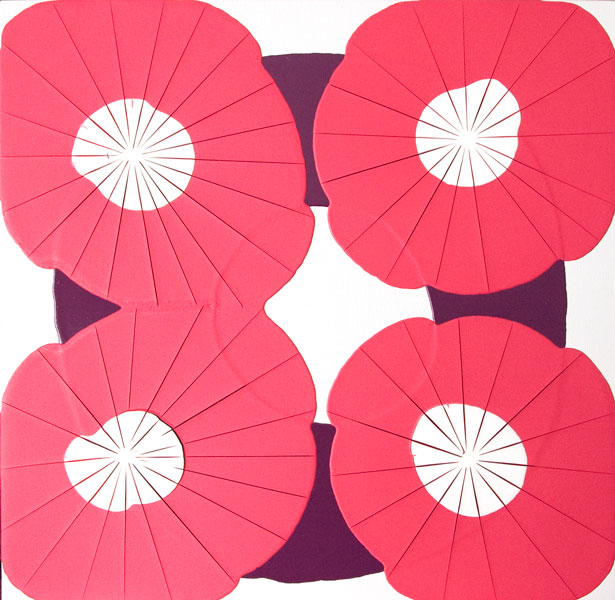
Chris Rywalt, Franklin at Class, 2010, Conté on paper, 5.5x8.5 inches
I attended about three hours of #class yesterday. Franklin all but requested that I write it up so here I go. I'm not sure it's a good idea (or a good investment of time) but I'll do it anyway.
What is #class? Basically, William Powhida and Jen Dalton took over Ed Winkleman's gallery, painted the walls with blackboard paint, put some tables and chairs in the middle of the room, and called it #class. Over the course of the past month they've invited various people in to talk, discuss, hang out, do yoga, draw on the walls, and so on.
Let me explain how I was feeling going in: I was a little uncomfortable. I was going entirely to support Franklin. I had no desire to go myself. I'd written bad things about some of the people there. I'd stopped speaking to some of them. So I went in expecting a negative atmosphere. I figured there would be some heated discussion, maybe some serious disagreements. I was hoping there'd be a fistfight, because that would be cool and old-fashioned, something that could go into the art history books, like when Willem de Kooning punched Clement Greenberg in the Cedar Tavern. So I tried to prepare myself mentally for it. I thought about what I might respond to various things people might say. I arranged possible arguments for topics that might come up. I tried to concentrate on absorbing other people's statements slowly, because I've found that I tend to accept what people say without fully grasping it until much later, and only then do I understand where we disagreed. So I wanted to make sure I thought more deeply about the conversation as it was happening instead of getting too caught up in the moment.
All of which turned out to be wasted effort because absolutely nothing interesting happened at all.
I arrived about a half hour before the end of Ben Davis' talk on "9.5 Theses on Art and Class". I recognized about half the people in the room: James Wagner, Barry Hoggard, Joanne Mattera, Man Bartlett (he had his furry hat on), Ed Winkleman, William Powhida, Jen Dalton, and of course, Franklin. Shortly after I sat down Piri Halasz arrived, introduced herself to me, and found a seat next to me. Ben was standing and mostly leading the discussion, which had wandered into whether the government should pay people to be artists or not.
I realized as I sat there listening that I actually didn't mind the very basic idea of #class, which was getting a bunch of people together to talk about art. Here I was, getting a chance to meet Piri, who I'd only known online, and seeing Franklin visiting from Boston, and saying hello to Joanne, who I like very much. Just putting people together that way, it's a good thing.
I realized what I object to about #class is the insistence that this be art. It's not art. It's talking. I feel no need to expand the definition of art to include a conversation, a shared meal, or a happening. Or I should say I feel no need to accept the expansion that's already been going on for the past sixty years or so. In fact I think it's a good idea to start narrowing the definition down again, throwing out things that have been dragged under the umbrella of art. And this group of people sitting around bullshitting? It doesn't have to be art.
You can go and sit through the hours of video of the event if you feel so inclined. At 1:12:45 you can see Franklin wave to me as I walk by the door (he had a view of the street from his perch) and at 1:13:04 you can see me walk in and sit down right at the bottom of the camera frame. From then on you can stare at my bald spot. Note that I pull out the New York Times crossword and completely fail to fill in any answers.
While I sat there I checked out the blackboards around the room. One of the attendees had brought in her kindergarten class earlier so the boards were filled to kindergartner height with drawings, all of which together had more charm, energy, intelligence and fun than anything anywhere else in the room. You know how the anti-art cliche is "My kid can do that"? Well, your kid can't, because she's too creative.
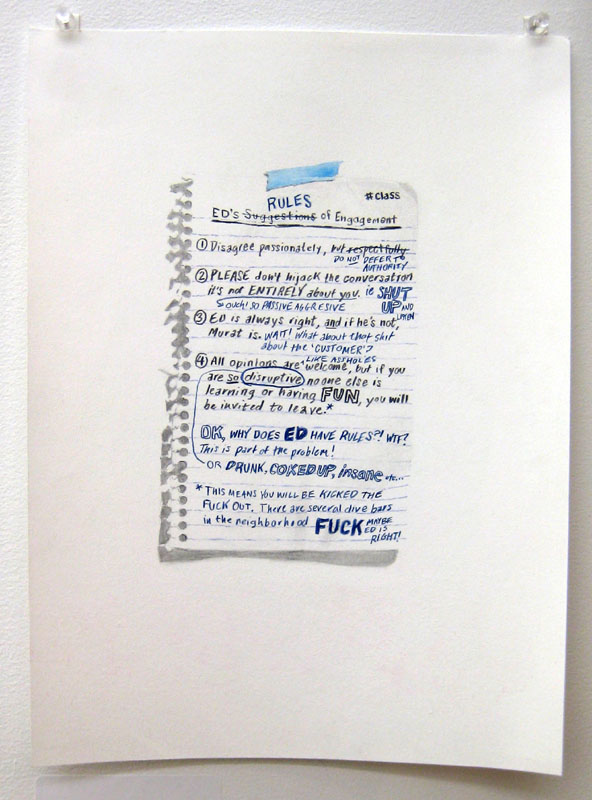
William Powhida, Ed's Rules, 2010, pencil, colored pencil and watercolor on paper, 14x11 inches
Ben's session ended and some people left and some stayed. William Powhida came over and introduced himself to me and I introduced him to Piri. He shook my hand. Bill said something to Piri about how we'd argued a bit online but that was closest we came to that fistfight. (I always want to be one of those people who looks at the proffered hand for shaking coldly and with scorn but it never works out. I always end up shaking hands.)
Somewhere in there Agni Zotis came in, which was kind of funny, since I only know her because John Morris rented her gallery space for the Blogger Show back in 2007. How she ended up at #class I don't know, except that maybe the art world really is a small place.
Also George showed up. I have no last name or link for George because I don't know anything about him, except that he wears a hat and used to comment a lot on Franklin's blog. We'd all argue and everyone else can't stand George but I don't mind him.
You can read Franklin's talk when he posts it on his site. His position wasn't a surprise, that conceptualism makes for bad art. He approached this by taking a satirical tone, saying that conceptualism is great, and then going on to explain why it's great, which is that anyone can make anything into art with no effort at all. Someone had written high up on one wall "IRONY IS: OFF" and Franklin, as he began, got up and erased OFF, writing in "ON".
I have to admit that I found Franklin's reading his essay off the paper to be less than exciting. His delivery wasn't helped by his occasional pauses for laughter which wasn't forthcoming. Piri and I certainly chuckled at some of it, and others around the room did at other parts, but I think there simply weren't enough people in the audience to have that necessary critical mass. The group was classroom sized, which is, I think, exactly the wrong size for a talk like Franklin's: You either need more people or fewer.
Things picked up after he'd finished reading and began speaking extemporaneously. That's when the Franklin I'd expected arrived, intelligent and witty and interesting. Unfortunately that's when everyone else got a chance to speak, too.
If you've ever attended a town council meeting, school board meeting, PTA meeting, recreation soccer coaches' meeting, Boy Scout camping trip planning meeting, or any other of the various meetings that dot the American social landscape, then you know exactly what the discussion period was like. I can sum up the problem in three sentences: Everyone has ideas. Everyone wants their ideas to be heard. Almost all of their ideas are stupid.
The trouble is most people pick up ideas the way they might pick up burrs on their pant legs as they stroll across a meadow. They don't know what they are, exactly, how they got there or what they do, and they don't know what to do with them, but they're willing to pluck them off and throw them at you. People think they understand these ideas but they don't; they've collected them somehow, can't really think about them properly, haven't fit them in to anything else, but will freely bandy them about as if they know what they're doing. They're so ignorant they don't even know they're ignorant. They end up dealing with concepts that have troubled the finest minds humanity has ever produced, but since they have no idea of any of the work that's gone into these concepts, they come to their own unfounded and inane conclusions and feel they've done some fine thinking.
For example, one fellow claimed that one plus one equals two might have some different meaning in another culture. One lady declared that ideas have aesthetic qualities, apparently having decided that she can just redefine the word "aesthetic" to her own liking. Bill started talking about a priori knowledge. All of this was covered by Kant in more depth than any of these people will ever comprehend. You can't argue with them -- the only thing I could imagine is telling them to go read Kant's Critique of Judgment and come back when they understand it. Personally I'm still working on it.
At one point in his opening essay Franklin listed several possible arguments a conceptual artist might use against a critic of their work. But he failed to anticipate the best argument yet, which is simply to claim that you're not a conceptual artist at all. Franklin carefully defined conceptual art as art which hinges its success primarily on its ideas. This passed without comment initially but later a few people objected to this. As near as I could figure it, at least three attendees felt that conceptual art was about more than ideas and wasn't what they were doing anyway.
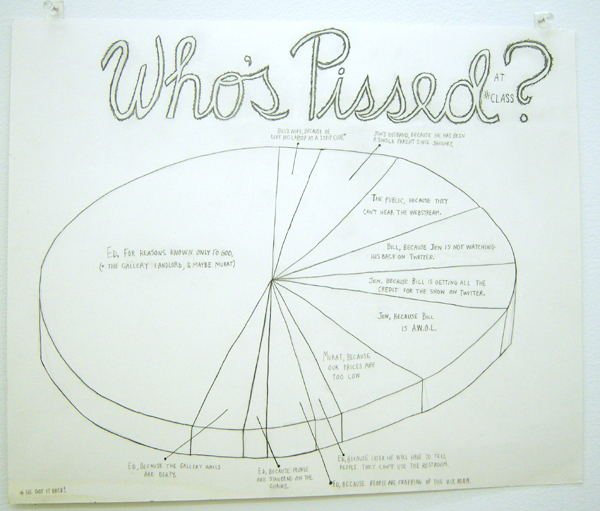
Jennifer Dalton, Who's pissed at #class, 2010, Pencil on paper, 19x22 inches
Jen Dalton actually claimed -- and unfortunately the recording stops before this point so I have to quote from memory here -- Jen said, "I'm not a Conceptualist. I really care about how my work looks!" And I could only think, Oh my god. You really care about the aesthetic quality of your pie chart illustrating the percentage of male artists supported by their spouses? That means your work fails on every possible level! I mean, honestly, does Jen really believe that she cares about how her work looks the same way, for example, Morris Louis cared about the way his work looks? How do you argue against this level of delusion?
The answer is, you don't. You sit there quietly in the back, under the surveillance camera, and you say nothing because you realize it's hopeless. These people have burrs to throw around and they're going to throw them and what are you going to do? Throw your own? Better to opt out.
The high point, for me, was when Ed, apropos of nothing, while Franklin was talking, got up and wrote on the blackboard over Franklin's head -- I think this was after the video stopped recording -- "BEAUTY = PATRIARCHAL" and under that "COMPELLING = NOT" followed by ditto marks. This was after a couple of the not-Conceptualists discussing with Franklin got it into their heads that conceptual art isn't about being "interesting" so much as it's about being "compelling", although what the difference is, and what it has to do with the patriarchy, I don't know. The fact that "BEAUTY = PATRIARCHAL" completely undercut everything Franklin was saying about beauty -- that it's a human universal, that it transcends culture, that it's worth achieving, that it's the highest goal of true art -- didn't seem to faze Ed in the least. This is how you get a reputation for being even-handed -- by being very fast and subtle in your under-handedness.
Eventually the discussion wound down. Afterwards I got to chat with a few different people. Piri had left early to see a few shows while she was downtown but Joanne was still around. While we were talking one of the other attendees interrupted us. She'd mentioned she was working on her doctorate during the discussion so Joanne politely asked her about her thesis. I knew this was a mistake. The woman rattled off the title of her dissertation -- sadly I didn't record it for posterity -- and Joanne meekly replied, "That went over my head." I could've told Joanne it didn't go over, it went under her head. The title was that thoroughly, inexpressibly stupid. Well, what would you expect from someone with a homemade business card declaring themselves to be an "Ecological Artist"?
Anyway, in the end it didn't matter if the average IQ at #class approached room temperature. Not only did no one know what they were talking about, none of them had any ability to affect anything, either. You'd be better off attending a colloquy of capybaras on the topic "Towards a Clearer Understanding of the Steering of Ocean Liners". They'd have more basic comprehension of the subject and be more capable of affecting it.
Behind me on the wall was written something along the lines of "We've been accused of being whiny so for the last four days SOLUTIONS ONLY!" In that spirit let me offer this solution for everyone who attended any part of #class. In fact, this is my solution for anyone who is dissatisfied with the state of the art world, a bad review they received, or, really, anything at all. Here is my solution: BE BETTER. Not better than you were yesterday. Not better than you thought you might be. Not better than your neighbor or better than your mother expected. No. Measure yourself against the best and try to be better. You'll most likely fail, but that's okay. Keep trying. All that's good in the world has sprung from that one impulse: BE BETTER.

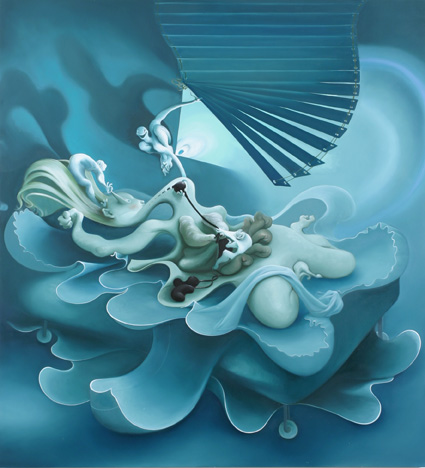
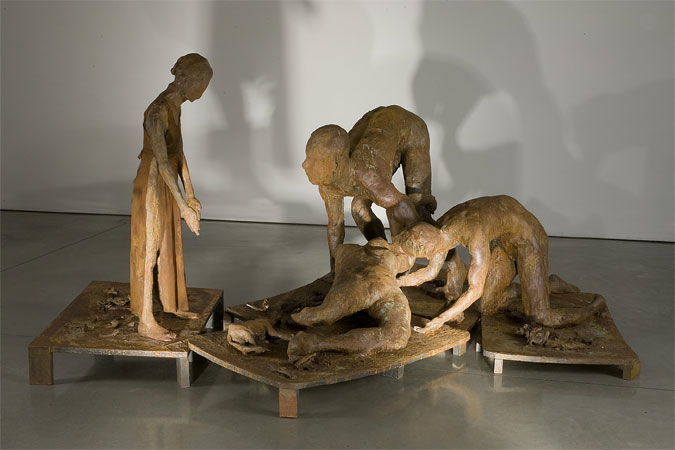
-by-Tracy-Helgeson.jpg)
-by-Tracy-Helgeson.jpg)
